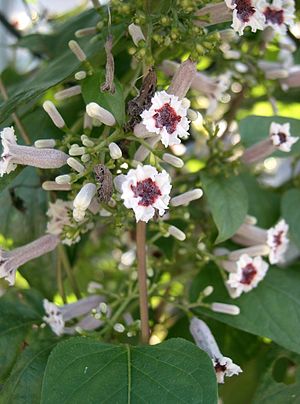Note: This is a project under development. The articles on this wiki are just being initiated and broadly incomplete. You can Help creating new pages.
Difference between revisions of "Paederia foetida - Gandha prasarini"
| (One intermediate revision by the same user not shown) | |||
| Line 1: | Line 1: | ||
[[File:Paederia scandens2.jpg|thumb|right|''Gandha prasarini'', ''Paederia foetida'']] | [[File:Paederia scandens2.jpg|thumb|right|''Gandha prasarini'', ''Paederia foetida'']] | ||
'''Gandha prasarini''' is a an important ayurvedic herb. It is a vigorous climber with purple and white flowers. Leaves when crushed emit an unpleasant smell, which is what led to its various vernacular names. | '''Gandha prasarini''' is a an important ayurvedic herb. It is a vigorous climber with purple and white flowers. Leaves when crushed emit an unpleasant smell, which is what led to its various vernacular names. | ||
| − | |||
==Uses== | ==Uses== | ||
{{Uses|Rheumatism}}, {{Uses|Paralysis}}, {{Uses|Diarrhea}}, {{Uses|Dysentery}}, {{Uses|Infertility}}, {{Uses|Flatulence}}, {{Uses|Inflammation}}. | {{Uses|Rheumatism}}, {{Uses|Paralysis}}, {{Uses|Diarrhea}}, {{Uses|Dysentery}}, {{Uses|Infertility}}, {{Uses|Flatulence}}, {{Uses|Inflammation}}. | ||
| Line 9: | Line 8: | ||
==Chemical Composition== | ==Chemical Composition== | ||
| + | Foetida also contains friedelin, campesterol, ursolic acid, hentriacontane, hentriacontanol, ceryl alcohol, palmitic acid and methyl mercaptan 5. Ellagic acids 15, Epifriedelinol, Terpenoids, alkaloids paederine (a-paederine and b-paederine), volatile 16 and an essential oil.<ref name="Chemical Composition"/> | ||
==Common names== | ==Common names== | ||
| − | {{Common names|kn=Gabbu balli, hesarane|ml=Lepcha, talanili|sa=Prasarini, gandhapatra|ta= | + | {{Common names|kn=Gabbu balli, hesarane|ml=Lepcha, talanili|sa=Prasarini, gandhapatra|ta=Cankai-p-pinari, Muthiar koonthal|te=Saviraela chettu, Gonthe mogaru chettu|hi=Prasaran, Bakuchi|en=Skunkvine, Stinkvine}} |
<ref name="Common names"/> | <ref name="Common names"/> | ||
| Line 73: | Line 73: | ||
<references> | <references> | ||
<ref name="Common names">[http://envis.frlht.org/bot_search Vernacular names]</ref> | <ref name="Common names">[http://envis.frlht.org/bot_search Vernacular names]</ref> | ||
| + | <ref name="Chemical Composition">[https://ijpsr.com/bft-article/paederia-foetida-linn-phytochemistry-pharmacological-and-traditional-uses/?view=fulltext#:~:text=and%20paederoside)%2014.-,P.,and%20an%20essential%20oil%2015. Chemical Composition]</ref> | ||
<ref name="Leaf">[http://florakarnataka.ces.iisc.ac.in/hjcb2/herbsheet.php?id=4564&cat=1 BOTANIC DESCRIPTION]</ref> | <ref name="Leaf">[http://florakarnataka.ces.iisc.ac.in/hjcb2/herbsheet.php?id=4564&cat=1 BOTANIC DESCRIPTION]</ref> | ||
Latest revision as of 11:50, 26 June 2020
Gandha prasarini is a an important ayurvedic herb. It is a vigorous climber with purple and white flowers. Leaves when crushed emit an unpleasant smell, which is what led to its various vernacular names.
Contents
- 1 Uses
- 2 Parts Used
- 3 Chemical Composition
- 4 Common names
- 5 Properties
- 6 Habit
- 7 Identification
- 8 List of Ayurvedic medicine in which the herb is used
- 9 Where to get the saplings
- 10 Mode of Propagation
- 11 How to plant/cultivate
- 12 Commonly seen growing in areas
- 13 Photo Gallery
- 14 References
- 15 External Links
Uses
Rheumatism, Paralysis, Diarrhea, Dysentery, Infertility, Flatulence, Inflammation.
Parts Used
Chemical Composition
Foetida also contains friedelin, campesterol, ursolic acid, hentriacontane, hentriacontanol, ceryl alcohol, palmitic acid and methyl mercaptan 5. Ellagic acids 15, Epifriedelinol, Terpenoids, alkaloids paederine (a-paederine and b-paederine), volatile 16 and an essential oil.[1]
Common names
| Language | Common name |
|---|---|
| Kannada | Gabbu balli, hesarane |
| Hindi | Prasaran, Bakuchi |
| Malayalam | Lepcha, talanili |
| Tamil | Cankai-p-pinari, Muthiar koonthal |
| Telugu | Saviraela chettu, Gonthe mogaru chettu |
| Marathi | NA |
| Gujarathi | NA |
| Punjabi | NA |
| Kashmiri | NA |
| Sanskrit | Prasarini, gandhapatra |
| English | Skunkvine, Stinkvine |
Properties
Reference: Dravya - Substance, Rasa - Taste, Guna - Qualities, Veerya - Potency, Vipaka - Post-digesion effect, Karma - Pharmacological activity, Prabhava - Therepeutics.
Dravya
Rasa
Tikta (Bitter)
Guna
Guru (Heavy), Sara(Flowing)
Veerya
Ushna (Hot)
Vipaka
Katu (Pungent)
Karma
Kapha, Vata
Prabhava
Habit
Identification
Leaf
| Kind | Shape | Feature |
|---|---|---|
| Simple | Opposite | Leaves opposite, ovate, nearly glabrous, with a long petiole |
Flower
| Type | Size | Color and composition | Stamen | More information |
|---|---|---|---|---|
| Bisexual | White and purple | Inflorescence of panicled cymes, axillary and terminal. Flowers sessile or pedicelled |
Fruit
| Type | Size | Mass | Appearance | Seeds | More information |
|---|---|---|---|---|---|
| Broadly elliptic | Compressed with 2 dorsally compressed pyrenes | {{{6}}} |
Other features
List of Ayurvedic medicine in which the herb is used
Where to get the saplings
Mode of Propagation
How to plant/cultivate
Cuttings may be planted in raised beds at 10 cm apart row and 5 cm within a row. Double node stem with leaves is recommended for planting in the month of August and September. Seed germination is low, around 25-30%.[5]
Commonly seen growing in areas
Tropical area, Sub tropical area.
Photo Gallery
References
External Links
- Ayurvedic Herbs known to be helpful to treat Rheumatism
- Ayurvedic Herbs known to be helpful to treat Paralysis
- Ayurvedic Herbs known to be helpful to treat Diarrhea
- Ayurvedic Herbs known to be helpful to treat Dysentery
- Ayurvedic Herbs known to be helpful to treat Infertility
- Ayurvedic Herbs known to be helpful to treat Flatulence
- Ayurvedic Herbs known to be helpful to treat Inflammation
- Herbs with Leaves used in medicine
- Herbs with Roots used in medicine
- Herbs with common name in Kannada
- Herbs with common name in Hindi
- Herbs with common name in Malayalam
- Herbs with common name in Tamil
- Herbs with common name in Telugu
- Herbs with common name in Sanskrit
- Herbs with common name in English
- Habit - Climber
- Herbs that are commonly seen in the region of Tropical area
- Herbs that are commonly seen in the region of Sub tropical area
- Herbs
- Bignoniaceae
- Plants of western ghats




